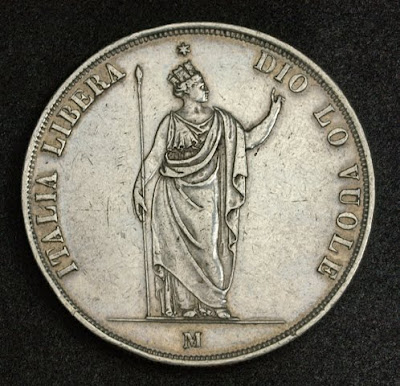 |
| Italian States - Lombardy Venetia 5 Lire Silver coin |
 |
| Italian States Coins - 5 Lire Silver coin Lombardia |
Italian coins, Italian Coinage, Italian silver coins, Numismatic Collection, Coins of Italy best silver coins for investment, Italian Gold Coins, Italian States Coins, Coins of Italy, Coins of the Papal States, Gold coins of Italy, Vatican Coins, Vatican Gold Coins, Italian colonial coins.
Obverse: Togate standing Lombardia (or Tyche) wearing turreted crown, looking right, spear in right hand. Star beneath head above.
Legend: ITALIA LIBERA DI LOMBARDIA 1848
Exergue: M (Milan Mint)
Reverse: Denomination ("5 LIRE ITALIANE") within wreath.
Legend: GOVERNO PROVISORIO DI LOMBARDIA 1848
Mint Place: Milan
Denomination: 5 Lira
Reference: Davenport 206, Pagani 213, KM 22.1.
Weight: 24.95 gm
Diameter: 37 mm
Kingdom of Lombardy–Venetia
The Kingdom of Lombardy–Venetia, commonly called the Lombardo-Venetian Kingdom (Italian: Regno Lombardo-Veneto, German: Königreich Lombardo–Venetien), was created at the Congress of Vienna in recognition of the House of Habsburg-Lorraine's rights to Lombardy and the former Republic of Venice after the Napoleonic Kingdom of Italy, proclaimed in 1805, had collapsed. The kingdom was ruled day-to-day by viceroys appointed by the Imperial Court and resident in Milan and Venice.The Congress of Vienna combined the territories of Lombardy (which had been ruled by the Habsburgs since the 16th century, and by the Austrian branch of the family from 1713 to 1796) and Venetia (which had been under Austrian rule intermittently since 1797) into a single unit under the House of Habsburg-Lorraine.
Administratively the Kingdom comprised two independent governments in the two parts. Lombardy included the provinces of Milan, Como, Bergamo, Brescia, Pavia, Cremona, Mantova, Lodi-Crema, and Sondrio. Venetia included the provinces of Venice, Verona, Padova, Vicenza, Treviso, Rovigo, Belluno, and Udine.
The Kingdom of Lombardy–Venetia was first ruled by Francis I from 1815 to his death in 1835. Ferdinand I ruled from 1835 to 1848. In Milan on 6 September 1838 he became the last king to be crowned with the Iron Crown of Lombardy. The crown was subsequently brought to Vienna after the loss of Lombardy in 1859, but was restored to Italy after the loss of Venetia in 1866.
After a popular revolution on 22 March 1848 (The Five Days of Milan), the Austrians fled from Milan, which became the capital city of the Governo Provvisorio della Lombardia (Lombardy Provisional Government). The next day, Venice also rose against the Austrians, forming the Governo Provvisorio di Venezia (Venice Provisional Government). The Austrians, after defeating the Sardinian troops at the Battle of Custoza (24–25 July 1848), entered Milan (6 August) and Venice (24 August 1849), and restored Austrian rule.
Francis Joseph I ruled over the Kingdom for the rest of its existence. His younger brother Maximilian (who later became Emperor of Mexico), served as his viceroy in Milan between 1857 and 1859.
Lombardy was annexed to the embryonic Italian state in 1859, by the Treaty of Zurich after the Second Italian War of Independence; Venetia was ceded to the Kingdom of Italy in 1866 in the aftermath of the Seven Weeks War, by the Peace of Prague.
Five Days of Milan
The Five Days of Milan were a major event in the Revolutionary Year of 1848 and the start of the First Italian War of Independence. On March 18, a rebellion arose in the city of Milan, and in five days of street fighting drove Marshal Radetzky and his Austrian soldiers from the city.In 1848, the Milanese launched an anti-Austrian campaign as early as the first of January. On New Years Day the Milanese started to boycott gambling and tobacco products, which were Austrian monopolies and brought in over 5 million lire a year. Archduke Rainer Joseph of Austria, viceroy of Lombardy and Venetia, retaliated by ordering out police with cigars to provoke the crowd.
The boycott culminated in a bloody street battle on the third of January, when Austrian soldiers, in batches of 3 were being insulted and pelted with stones by an angry crowd. Now, the soldiers gathered together in groups of a dozen and charged the crowd with swords and bayonets, killing 5 and wounding another 59.
Radetzky was horrified at the doings of his troops and confined them to five days barracks. The protests were over, but two months later, when news reached Milan of the uprising in Vienna and the fall of Metternich, the Milanese took to the streets again, on 18 March.